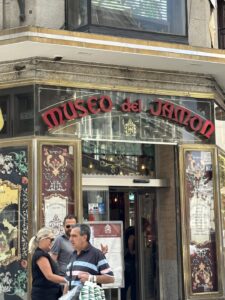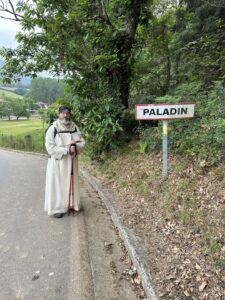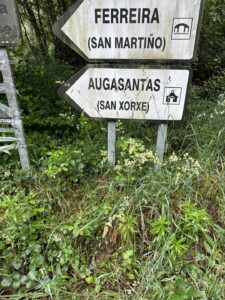With Spring all sprungen and allergies going off, I am having a weird sensation of being unstuck in time. It is hard to believe almost a year as passed since we walked the Camino Primitivo, seems like it was just the other week, with a side order of anxiety that I am not training to get ready for the Camino. As if I need to be getting ready to do it again at the end of May. What it does mean is that I need to do some more work on Part 2. If you’d like to read Part 1 first, go for it. In the interest of keeping posts under 3000 words, just barely in this case, yes, there will be a Part 3.
FOOD

My takes on food in a place are always going to be a bit weird due to my dietary restrictions: unless it’s whale, I can’t eat seafood. Well, I can eat seafood but the consequences of what I will do to someone’s bathroom for the next several hours may constitute an international incident. This is how I introduce to you the concept that despite spending all your time walking in the hills and mountains of Asturias and Galicia on the Camino Primitivo, you’re rarely all that far from the Bay of Biscay and the regional cuisine is very proud of it’s seafood. This was very unfortunate for me.
When you’re a peregrino, in addition to having access to the alburgues to sleep in at a cheap rate, many establishments while have a peregrino food special that is discounted. Or it will be the normal price but a much larger portion to help give those calories back to you. At the end of our first day when we stopped at Escamplero, we hobbled to the restaurant & bar to see what was available to eat. The special was a cauldron of Asturian sausage soup that was sausage which Fr. Gabriel and I couldn’t finish a single serving of between us. A week of walking later, when served a similar cauldron, I demolished the entire thing myself and was considering asking for more. Unfortunately, because we were so close to the Atlantic, the delicious and hearty regional soups are sometimes made with shrimp or with fish stock. I didn’t ask one time and hooboy was that a mistake. Didn’t sleep much that night and spent most of it in the toilet, violating the nose of whichever Russian bicyclist had to use it after me.
If you are someone that can eat seafood, the locals are very proud of their pulperias. Fr. Gabriel was foolishly abstaining from seafood because I couldn’t eat it. I told him he was dumbass, don’t inflict my limitations on himself, and have some damn octopus. The last time I saw him that happy putting something in his mouth, it was the first time he had Hangar One vodka at St. George Spirits. But I don’t want you to think I spent all of my time in Spain being poisoned or denied delicious things. Goodness no.

Skipping forward to our final days in Madrid, we had a hotel that was next to Taco Bell. We did not eat there. Instead, we went to the Museo de Jamon, which is not a museum but a restaurant. Admittedly, the near pornographic display of so many fine Iberico hams certainly felt museum-worthy. Per our server, tourists regularly show up there expecting a museum and he wanted to make sure we were there to eat. The next day, for our final dinner, there was a place that specialized in paella, because Fr. Gabriel felt to would be crime to go to Spain and not have paella. I looked at the menu in awe because while there were seafood based paellas on the menu, they were a distinct minority. I was excited by this and told our server.
Me: You have paella without seafood!
Server: Yes?
Me: This is amazing!
Server: Proper paella is made with snails and rabbit.
Me: [excited] Is that on the menu?
Server: No, but you can make paella with whatever. The key is to get the rice right.
Me: The United States doesn’t seem to have gotten this message.
So, I get it now. I finally understand why everyone is excited to order paella. I someday hope to get eat paella again but careful watch of menus in the last year since coming home hasn’t given me hope. America, get your shit together.

Back on day two of our walk, Fr. Gabriel likes to joke that he is level 2 Cleric with one level of the Knight prestige class, but he is not a paladin no matter what this town’s sign says. But more importantly, it was time for lunch and we were very ready to drop our packs and take off our shoes, we stopped at the Villa Palatina Superior Hotel. There was a sign on the restaurant patio that said they had won a prize, in the International Cachopo Competition, for the Best Cachopo In The World. We didn’t know what a cachopo was, nor was our Spanish good enough for them to adequately describe it to us, but we intended to find out. But we did know if it was the Best Cachopo In The World, we would be fools to pass it up. With our limited Spanish, we figured out it was something fried with a potato item as well, which sounded good enough by us. Spain dared to ask the question “What if we could incorporate cheese into weinerschnizel with double the meat?” and the answer is the culinary delight cachopo (or caxopo). We ate cachopo several more times on the Camino but none were as good as theirs. They legit won that award.
WHAT’S WITH ALL THE Xs?
Once upon a time, I picked up a bit of bar trivia which I then happily shared that any time you find an X in Spanish that you’d found a borrow word from native languages that came from New World back to Spain. Chocolate (xocatil), Mexico, etc. Yeahhhh, that’s horseshit and walking through Galicia taught me better, or at least it’s not quite the simple. The concepts of the nations of Spain and Mexico aren’t that simple either.
Think of the words “Oaxaca”, “Mexico”, and the name “Xavier”. How do you pronounce the X in those words? If you’re an English speaker who doesn’t know any better, you likely default to the clashing hiss /ks/ sound. But if you do know the local pronunciations, you know that X is actually closer to breathy H sound. For added fun, you may also know that the Spanish form of Xavier is Javier, with the J as H sound most people are accustomed to in Spanish. So what’s with up with X here?
First, we need some history. Mexico wasn’t always Mexico. The Spanish Empire established a variety of viceroyalties in the New World with very creative names like Nueva España, Nueva Leon, Nueva Granada, and most important for this tale, Nueva Galicia. Nueva Galicia was somewhat unique in the Spanish Empire as it was mostly settled by folks from old Galicia who got sent into the rugged interior. I assume the thinking was along the lines of “Send the hillfolk to settle the hills.” Once they arrived and met the native populations, they then proceeded to ask the important questions that any visitor to a new place asks:
- What do you call this place?
- What is that delicious thing we just ate?
- What was that thing that killed Bob?

Because the local languages the settlers from Galicia ran into had some phonemes that the Spanish ear didn’t quite pick up, they used X for those sounds they weren’t quite sure on when they did their transliterations. This is because Galicians ALREADY USED X IN THEIR SPELLING. In Galicia, X is already in use for the English H sound, /ks/, something vaguely Z like, and sometimes even S like. When the English borrowed Xavier from their most convenient Spaniards, the folks in Galicia, they took the Galician spelling of Javier and the promptly mispronounced it. All those words the Galicians wrote down in the hills of New Galicia rolled back down across the plain to Veracruz, on to boats, and then back to Madrid where these new words got adopted into more general Spanish.
This is the linguistic equivalent of the classic joke of “You can’t have X, we have X at home” except X isn’t just a placeholder here, it’s the actual letter. Spain, you didn’t have to go to hills of Mexico to bring X into your language, you only had to go a few hundred kilometers to the northwest of Madrid. But there’s a reason they didn’t, as expressed to me by the desk clerk at our hotel in Madrid:
“They don’t speak Spanish. It’s [with a face of disgust] Galician.”
So, there you go. Galician had to be purified by the crucible Mexico to be allowed to come back. Also, PROTIP, any Spanish colloquialisms you may have learned in Mexico may not play particularly well in Madrid. And unless you like getting the “Did you just scratch your ass and offer to shake my hand?” face never, ever ask where los baños are in Spain. Try los servicos, but even that’s too crude in the north where they prefer los aseos. My personal translation is “ass place” and I refuse alternate etymologies.
FLORIDA MAKES SENSE NOW
Once people who once they start learning anything about the Conquistador Era of colonization, which the French & English then refined, they often boggle at how the Spanish arrived at the utterly horrific system of turboslavery that they did. To which I give a sad chuckle and say, oh, this doesn’t just happen. The Spaniards weren’t uniquely evil and creative in the New World. No, they’d been practicing at this for centuries already. This system, which is called encomienda, is was how the Reconquista was won.
During the Reconquista, to help secure the ever advancing, newly conquered southern frontiers of the kingdoms of Spain, they need to encourage migration and settlement to secure these new lands. The Crown would make land grants to people willing to settle in these area, often as a reward for military service, sometimes in thanks for being a financier of the Crown. It was still risky so you weren’t going to do that without a serious incentive, but the Crown had one. You weren’t allowed to enslave Christians but you were permitted to do so to any Muslims or Jews you might find there. As an A+ demonstration of perverse incentives, this was a stronger conversion drive than the Inquisition ever was but it also weakened the value of these grants. So, NEW DEAL, the grantee, the encomendor, was allowed also granted the ability to command the labor of a negotiated number of people within their granted lands. TOTALLY different from slavery, just negotiated contract serfdom. Of course, the peasants that were already there continued to be peasants except they were officially registered as associated to your grant in association with the local parishes and the dioceses. Not allowed to leave, still were peasants that owed rents, but not slaves. But the most important part of this system is that the encomienda exists at the discretion of the Crown and the encomendor owed the Crown for the privilege. The other incentive was that the encomendor rights were hereditary, giving rise to the “sword nobility” which would become a bit of a problem for Spain in a few more centuries.
This is the nasty philosophy behind every conquistador expedition to the New World. These weren’t just explorers, these were founders that seriously fucking owed the VC backers in Madrid. Marc Andreessen might not torture you and your family to death if you fail to found a unicorn company, but the Spanish Crown certainly would their captains sent across the sea.
Because 1492 was a helluva year. To folks in the Americas, this marks Columbus reaching Hispaniola and opening the New World to Spain. Back in Spain, 1492 marks the Fall of Granada and thus the end of the Reconquista. There is an argument to be made that had Columbus not returned to Spain that shit might have gotten dire. That Spain might have needed to keep the good times rolling right into North Africa or, more likely in my opinion and in keeping with the Iberian character, promptly fallen into bitter civil war. This is because with the end of the Reconquista a whole bunch of heavily armed and experienced soldiers who had suddenly lost their livelihood of conquest and future hopes of retirement & labor extraction. And, much worse, there were upcoming generations that now couldn’t become encomenderos, which was the ideal system to deal with the Excess Son Problem. Thank goodness there were these new continents to send them to!
To take us back to the earlier discussion of the Mexico before there was a Mexico, the population that left Spain to go to the New World was not an even distribution across the country. Much like if you take a random sampling of 10 Americans odds on favor you’re gonna get a Californian, you can’t avoid madrileños in the Spanish settlers but the Kingdoms of Asturias, Extremaduras, and Galicia are disproportionately represented. So many from Extremadura in fact that, unlike the rest of the Spanish federal states, they have a motto: Home Of The Conquistadors. To disparagingly explain why, for centuries upon centuries these were all regarded as places that were great to be from. Unless you really, really liked being a shepherd and being rained on continuously, perhaps you might want to seek your fortune literally anywhere else, doing anything else rather than in the ass end of Europe. This population was the backbone of the Reconquista, then of the conquistadors and they understood how the encomienda system worked. This is why Fr. Gabriel marveled at all the familiar names as we walked because all those Asturian and Galician families ended up in Nueva Galicia, and thus in New Mexico and the Philippines too.
One innovation that the Spanish Crown made for the system in the New World is that all lands belonged to the Crown and native peoples were declared to be have equivalent status as Castilian subjects, so the similarly were supposed to be exempt from slavery but they weren’t exempt from compelled labor as subjects. Instead, what we think of as conquistadors were more properly encomendors but were usually also military captains commanding troops. So, they’d be entitled to a contracted amount of labor from the native populations in the lands they’d been granted, but the trick was figuring out how to compel it (SEE ALSO: all the murder, infinite wars, and divide & conquer). And, hooboy, they better figure it out fast because the juice was running and they OWED the Crown; if you couldn’t pay in a timely manner, the Crown would be quite happy to name a new encomendor whose first order of business is to return you in chains to Madrid. The other innovation was that encomiendas in the New World weren’t hereditary, it only lasted two generations, in hopes of generating the settlements and freeholds that generated even more tax. One would hope that you and your family had found a way to become fabulously wealthy forever by the time your grandkids lost the contract.
Which brings me to Florida. Walking a lush path in Galicia one day, where it was hot & humid and the weather couldn’t decide if it wanted to rain or not, I bitterly remarked to Fr. Gabriel “Okay, I understand why someone from here might have gotten on a leaky boat, gotten to Florida and decided it wasn’t that all that bad.”
In general, encomiendas worked out pretty well for the Crown and the encomendors, less so for the native populations. So well in fact, Spain was granting them to anyone from anywhere provided you took a Hispanicized version of your name and swore to the Crown (the name the Russian fur trader José Bolchoff comes to mind). But there were some places where it just didn’t seem to work out, like La Florida. Successful encomiendas didn’t get a new encomendor and in a few generations it stopped and it wasn’t eligible for another. While Alta California was the new most remote place on Earth, relative to Madrid, at least it was pleasant and profitable, just…very far away. I have always said that Florida was a state founded on real estate scams but did not quite understand how this went all the way back. Florida was much closer to Spain but its rich resources consisted of [checks notes] tropical diseases, various bitey things and death at the hands of local tribes. The encomiendas in Florida failed every single goddamn time but the Crown seemed to find a never-ending string of suckers, mostly from Asturias, Extremaduras, and Galicia willing to give it a go. Ponce de Leon may have been the first true Floridian in that not only was he a failed encomendor but, after death enticed more to come to his deadly swampland with fanciful tales.
Until the advent of air conditioning, the settlement of Florida was barely more than pirate hideouts and cursory anti-piracy efforts. Some might argue not much has changed.